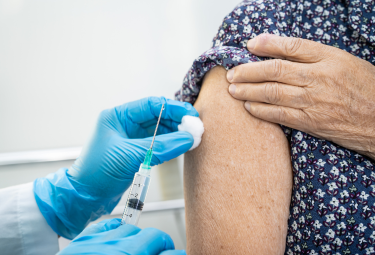Aging in Place: Growing Older at Home
August 12, 2025Many people want the same things as they get older: to stay in their own homes, to maintain independence for as long as possible, and to turn to family and friends for help when needed. Staying in your own home as you get older is called “aging in place.” But many older adults and their families have concerns about safety, getting around, or other daily activities. Living at home as you age requires careful consideration and planning. This article offers suggestions to help you find the help you need to continue to live independently.
Planning ahead for aging in place
The best time to think about how to age in place is before you need a lot of care. Planning ahead allows you to make important decisions while you are still able.
The first step is to think about the kinds of help you need now and might want in the future. You can learn about home-based care and other services in your community and find out what they cost. Planning ahead also gives you time to set up your home to meet your needs as you age.
Another step is to consider any illnesses, such as diabetes or heart disease, that you or your spouse might have. Find out about how the illness could make it hard for someone to get around or take care of themselves in the future. Your health care provider can help answer your questions.
Talk with your family, friends, and other caregivers about what support is needed for you to stay in your home. Be realistic and plan to revisit the decision as your needs change over time.
Support for aging at home
Home-based care includes health, personal, and other support services to help you stay at home and live as independently as possible. In-home services may be short-term — for someone who is recovering from an operation, for example — or long-term, for people who need ongoing help.
In many cases, home-based support is provided at home by informal caregivers, such as family members, friends, and neighbors. It can also be supplemented by formal caregivers and community services.
Help you can receive at home includes:
- Personal care: Help with everyday activities, also called “activities of daily living,” including bathing, dressing, grooming, using the toilet, eating, and moving around — for example, getting out of bed and into a chair
- Household chores: Housecleaning, yard work, grocery shopping, laundry, and similar chores around the house
- Meals: Shopping for food and preparing nutritious meals
- Money management: Tasks such as paying bills and filling out health insurance forms
- Health care: Help with many aspects of health care, including giving medications, caring for wounds, helping with medical equipment, and providing physical therapy
- Transportation: Assistance getting around, such as rides to the doctor’s office or grocery store
- Safety: Home safety features and help in case of a fall or other emergency
Find detailed information about in-home support services, including suggestions for arranging them, information about costs, and additional resources.
Making your home safe and accessible
There are a variety of ways to make your surroundings safer and easier to manage so they meet your needs as you age. Go through your home room by room to identify potential problems and safety issues. First, correct any immediate dangers, such as loose stair railings and poor lighting, and then work on other ways to ensure you will be as safe as possible at home.
See the Worksheet: Home Safety Checklist (PDF, 251K) for suggestions to help you identify and remove hazards around the house. Keep in mind that it may not be necessary to make all of the suggested changes. It is important, however, to reevaluate home safety every so often as your needs change.
Are you worried that making changes might be expensive? You may be able to get help paying for repairs and safety updates to your home. Check with your state housing finance agency, social services department, community development groups, or the federal government for financial aid programs and discounts. You can also visit the Eldercare Locator or call 800-677-1116 for help finding resources.
Resources for aging in place
If staying in your home is important to you, you may have concerns about getting around, being safe, and staying connected. Some of these activities become more challenging as you age. The resources below can help you find solutions.
Reach out to people you know. Family, friends, and neighbors are the biggest source of help for many older people. They may be able to drive you to doctor’s appointments, help with errands and chores, or just keep you company. Talk with those close to you about the best way to get what you need. If you are physically able, think about trading services with a friend or neighbor. For example, one could do the grocery shopping, and the other could cook dinner.
Learn about community resources. Your local Area Agency on Aging, local and state offices on aging or social services, or your tribal organization may have lists of services. These organizations will be familiar with resources available in your community and may have tips for accessing them. Health care providers and social workers may also have suggestions. If you belong to a religious community, find out whether it offers services for older adults or ask for guidance from your pastor, rabbi, or other religious leader.
Get help during the day. Support is available if your regular caregiver isn’t available during the day (for example, because they go to work). Some organizations have volunteers who regularly pay short visits to older adults. The volunteer can provide support, assistance, and companionship. Or you might consider an adult day care program, which can offer social activities, exercise, meals, and personal care during the day. Additionally, respite services provide short-term care for an older adult at home when a regular caregiver isn’t available.
Be prepared for a medical emergency. If you have a serious allergy or medical need, talk with your doctor about whether you should get a medical alert ID bracelet or necklace. You might also consider an emergency medical alert system, which responds to medical and other emergencies via an electronic monitor that a person wears. The monitor alerts emergency personnel when a person becomes lost, falls, or needs urgent medical assistance.
Talk to a geriatric care manager. These specially trained professionals can help find resources to make your daily life easier. They will work with you to form a care plan and find services you need. Geriatric care managers can be especially helpful when family members live far apart. Your doctor or other health care provider may be able to recommend a geriatric care manager, or you can contact the Aging Life Care Association for a list of these professionals in your area.
Look into government resources. Federal, state, and local governments offer many resources for older adults and their families and caregivers. A good place to start is the Eldercare Locator, which connects older Americans and their caregivers with trustworthy local support resources. Visit the Eldercare Locator or call 800-677-1116.
How much will it cost to age in place?
An important part of planning is thinking about how you are going to pay for the help you need. Home-based services can be expensive, but they may cost less than moving into a residential facility, such as assisted living or a nursing home.
How people pay for care depends on their financial situation, their eligibility for assistance programs, and the kinds of services they use. People often rely on a variety of payment sources, including:
- Personal funds, including savings, a pension or other retirement fund, income from investments, or proceeds from the sale of a home.
- Federal and state government programs, such as Medicare, Medicaid, and the U.S. Department of Veterans Affairs (VA). Visit USA.gov for more information about government programs for health care and financial assistance.
- Private financing, including long-term care insurance, reverse mortgages, certain life insurance policies, annuities, and trusts.
Read more about the options for paying for long-term care.
When it’s time to leave home
Most people prefer to stay in their own home for as long as possible. But there may come a time when it’s no longer safe or comfortable to live alone.
The decision about whether and when an older adult should move from their home is often difficult and emotional. Everyone will have their own reasons for wanting (or not wanting) to take such a step. One person may decide a move is right because they can’t or don’t want to manage the home any longer. For another person, the need for regular, hands-on care motivates a change.
Learn as much as you can about the housing options available as you grow older. Talk with your family about the pros and cons of each option before making a decision.
To learn more, please visit https://www.nia.nih.gov/health/aging-place/aging-place-growing-older-home.


